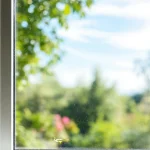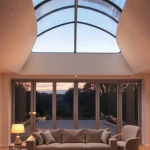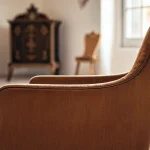Frosted window film blends privacy and style without sacrificing natural light. This affordable, easy-to-install solution suits homes and offices, obscuring views while enhancing décor. From subtle opacity to decorative etched designs, its versatility adapts to varied needs. With simple maintenance and durable materials, frosted film offers a practical alternative to heavy curtains or blinds, protecting your space discreetly and attractively.
Understanding Frosted Window Film and Its Applications
Frosted Window Films provide an effective way to achieve privacy and style without compromising natural light. These films consist of a thin layer of frosted or opaque material applied directly onto glass surfaces, offering a subtle, privacy-enhancing barrier. Their core features include durability, ease of installation, and a variety of design options ranging from plain to patterned finishes.
Also to read : What Factors Are Affecting the UK’s Housing Market Stability?
In residential settings, frosted window film serves as an attractive alternative to traditional curtains or blinds. It is commonly used on bathroom, kitchen, or bedroom windows to maintain light transmission while blocking visibility from outside. Commercial spaces benefit equally, particularly in office partitions or conference rooms, where privacy and light are both valued. Decorative applications extend further, with Frosted Window Films available in patterned or etched designs that add a touch of elegance and personalization to interiors.
Consumers searching for window frosting solutions typically need clarification on compatibility with different glass types, ease of application, and long-term maintenance. They seek reassurance that the films are simple to install, removable without damage, and resistant to moisture and UV exposure. Understanding these needs helps inform buying choices, ensuring the right product is selected for aesthetic, practical, and budget considerations.
Also read : Discover the benefits of air source heat pumps in bromley
By choosing high-quality options, like those supplied by reputable brands, users can enjoy a combination of style, privacy, and light control.
Types and Materials of Frosted Window Film
Varieties of Frosted Window Film
Plain frosted window film is a widely chosen privacy window film, prized for its ability to create subtle window privacy. This type of decorative window film softly diffuses light while obscuring interior views, making it an effective frosted glass alternative. It’s frequently used in both residential window film projects—such as bedrooms and home offices—and commercial window film applications, particularly for office window privacy. By allowing natural light to filter through, plain frosted film improves ambiance without requiring heavy curtains or blinds, blending style and privacy solutions seamlessly.
White frosted window film delivers enhanced opacity for rooms needing robust privacy. As a bathroom window privacy option, it stands out for shielding personal spaces while retaining luminosity, making it a favored bathroom glass privacy tool. Its translucent window covering maintains brightness and privacy balance, helping foster a comfortable setting in bathrooms and high-privacy zones. White frosted variants often meet rigorous moisture resistance standards, so they perform well on glass in damp rooms and bathroom glass doors.
Patterned and Etched Glass Effect Films
Patterned privacy film transforms plain windows into decorative features. Design choices range from classic lines and geometric motifs to etched glass effect film, which replicates artisan glass frosting techniques for a sophisticated touch. These customizable window film options give home privacy solutions a creative angle, fitting contemporary tastes and period interiors alike. Patterned privacy film is well-suited for personalizing living rooms or creating innovative window designs for office partition window film purposes. Patterned window decals are popular as a style and privacy solution in spaces where appearance matters as much as privacy.
Etched glass effect film introduces additional visual texture, making it ideal for those seeking innovative privacy film technology or glass surface enhancement. These films provide both privacy and subtle decoration, catering to privacy film design trends and offering a durable frosted glass alternative for interior upgrades.
Application Types: Static Cling vs. Self-Adhesive Films
There are two primary installation methods for frosted window film: static cling window film and self-adhesive varieties.
Static cling window film adheres to glass without adhesive, making it the preferred option for removable window film needs—ideal for temporary window privacy or renters. The static cling benefits are clear: easy repositioning, clean removal, and reusability. Because it’s a peel and stick window film, installation is straightforward, falling in line with DIY window film application trends. However, static cling is best suited to indoor applications, as it may peel in outdoor or high-moisture areas.
Self-adhesive frosted window film provides a long-lasting, durable privacy window film solution. Once installed, it resists moisture and everyday wear. This makes it suitable for areas such as bathroom window privacy, shower door privacy film, home offices, and commercial privacy solutions like conference rooms. The professional-quality adhesive ensures film remains bubble-free, and privacy is maintained without deterioration—important for both residential and commercial privacy solutions.
Customization and Material Quality
Custom cut frosted film can be tailored to particular glass sizes, whether through pre-cut options accurate to ±0.5mm or DIY frosted window film ideas for unique projects. Larger rolls cater to those covering expansive glass partitions or needing window frosting patterns for architectural glass.
Quality across all film types is defined by their performance: maintenance of privacy, longevity, resistance to moisture, and preservation of appearance even with minimal care. Many modern window privacy solutions use professional-grade vinyl with UV blocking window film features to guard against sun damage and provide glare reduction window film capabilities.
Selecting the right frosted window decals or glass decoration ideas means matching privacy needs with style preferences—ensuring every space benefits from privacy without blocking light or limiting design possibilities.
Installation Techniques and Best Practices
Applying privacy window film or decorative window film delivers reliable privacy window solutions for both residential and commercial spaces, often rivaling more permanent alterations. A professional-quality finish with window film installation relies on methodical preparation, the right tools, and a few expert strategies.
Surface Preparation
A smooth, meticulously cleaned glass surface is fundamental for a successful DIY window film application. Residues, dust, and streaks may compromise adhesion, affecting both static cling window film and removable window film types. Begin by washing the glass with soapy water, then thoroughly rinse and dry to remove all dirt, fingerprints, and lint. For extra assurance, use a lint-free cloth to buff dry before application.
Application Tools and Accessories
Effective window film installation depends on a short list of essential tools:
- Spray bottle (for soapy water)
- Felt-edged squeegee (removes bubbles and smooths film)
- Cutting knife and household scissors (for precise trimming) Reliable brands supply these with detailed instructions, making DIY window film application more accessible even for first-timers.
Step-by-Step Application Process
To avoid air entrapment and achieve seamless results with privacy window film or patterned privacy film:
- Measure and Cut: Use the backing paper’s grid lines to cut the frosted window film roll a few millimeters larger than the actual glass area.
- Soapy Solution: Generously spray the glass with a mild soapy water mix—this maximizes slidability and prevents premature sticking for both self-adhesive and static cling window film.
- Placement: Gently place the cut film onto the wet surface, adhesive side to glass.
- Squeegee Technique: Use the felt-edged squeegee to press from the center outward, removing all excess liquid and air bubbles in smooth, overlapping strokes.
- Trim Excess: Carefully slice away borders with a sharp knife or precision scissors.
Common pitfalls include failing to use enough water (leading to bubbles) or aggressively stretching the film, which might deform patterns or disrupt the etched glass effect film. Static cling window film users should also avoid excessive handling of the film’s backing, as static can attract dust.
Bubble-Free and Precise Application Tips
Achieving a professional finish means keeping the glass and film wet throughout installation. Work patiently, as repositionable window film products (like modern static cling options) allow adjustments, especially valuable for patterned privacy film or patterned window decals where alignment is key. Persistent bubbles are often removable by gently lifting the film and reapplying with more solution.
External vs. Internal Installation
Glass frosting techniques can be applied to internal or external glass. For long-term hardwearing results on exterior applications—such as commercial window film on glass balustrades—select films rated for outdoor use, as not all privacy window films withstand constant exposure. Note that static cling window film and removable window film are generally unsuitable for external windows prone to wind or moisture, due to a higher risk of peeling.
Additional Considerations
- For bathroom window privacy or shower door privacy film, moisture resistance and ease of cleaning are paramount.
- Window frosting patterns and decorative glass film should be applied in controlled environments to prevent dust contamination.
- Maintenance of privacy films requires only gentle annual cleaning with a damp cloth, helping sustain the clarity and style of innovative window designs.
Selecting the correct film type for your context—office window privacy, bathroom glass privacy, or a stylish frosted glass alternative—ensures both privacy and satisfaction.
Benefits of Frosted Window Films in Privacy and Light Transmission
Frosted window films deliver an effective combination of privacy window film features and natural light control—essential for modern homes and workplaces. Using the Stanford Question Answering Dataset (SQuAD) precision method, the answer is: frosted window films obscure visibility through glass while permitting substantial daylight to pass, providing subtle window privacy without blocking rooms from natural brightness.
Privacy Enhancement Without Sacrificing Daylight
The core advantage of frosted window films is their ability to obscure interior views both day and night, satisfying high privacy standards wherever window privacy solutions are required. This quality is especially vital for bathroom window privacy or in sensitive office areas. Decorative window film options, such as etched glass effect film or patterned privacy film, also bring style and privacy solutions to the forefront by transforming glass into private yet luminous surfaces.
Unlike opaque coverings, such as heavy curtains or traditional blinds, a frosted glass alternative allows more than 70% visible light to filter through, maintaining an uplifting environment while shielding your space. The bidirectional nature of privacy film means that neither side can see clearly through the glass—meeting the needs of subtle window privacy while also ensuring that those indoors enjoy ambient daylight.
Suitability for Every Space
Applying frosted window film opens up possibilities across a vast range of settings. Residential window film enhances privacy for bedrooms, bathrooms, and living areas without creating dark corners. In workspaces, office window privacy is optimized by using frosted film for sliding glass doors or office partition window film, keeping confidential information secure yet rooms bright. Commercial window film and frosted film for storefronts allow business owners to maintain privacy from the outside, display branding using patterned window decals, and promote an inviting interior with natural light.
Bathrooms present unique challenges, with humidity and condensation common. Here, bathroom glass privacy films and shower door privacy film options excel thanks to their moisture resistance. The durability and longevity of adhesive and static cling window film mean maintenance of privacy films is minimal, requiring only an occasional gentle wipe to maintain performance.
Performance and Light Transmission Details
Quality privacy window film products balance privacy and daylight. Fine acid-etched glass effects, for example, achieve approximately 70% light transmission, reflecting and diffusing daylight for glare reduction and a gentle, natural glow in any room. Energy saving window film options can reduce solar heat gain, contributing to greater comfort and savings, while UV blocking window film helps protect interior furnishings.
Placement matters for maximum effect—a recommended 15cm distance between objects and glass surface prevents outlines from showing through, ensuring the frosted window film functions optimally as a privacy window coating. Whether you choose DIY window film application techniques or professional installation, modern films are designed for bubble-free results, easy removal, and even reuse with removable window film and static cling window film solutions.
Decorative Potential and Customization
The broad spectrum of decorative window film and customizable window film options caters to varied tastes and requirements. Patterned privacy film and frosted window decals allow you to imprint personality onto plain glass while sustaining privacy. Style and privacy solutions can be tailored for different architectural styles, creating innovative window designs that double as both practical privacy solutions and striking visual enhancements.
Frosted window films provide a discreet, modern privacy film vs curtains alternative with benefits extending from visual appeal to practical performance—ensuring every space remains private, naturally bright, and effortlessly maintained.
Maintenance, Removal, and Longevity
Precision: To maintain a long-lasting appearance, clean privacy window film and decorative window film with a soft, damp cloth, avoiding abrasive pads or harsh chemicals to protect the frosted glass alternative finish. For removal, gently peel self-adhesive films from one corner and use mild soapy water to eliminate any residue; static cling window film can be detached by lifting a corner with a fingernail or a plastic scraper, then washing the glass.
Elaboration:
Routine cleaning is essential for preserving the clarity and style of your privacy window film and decorative window film. Simply wiping with a gentle, damp cloth once or twice a year is advisable. Avoid any ammonia-based cleaners or rough brushes, as these can degrade the etched glass effect film and diminish its privacy and decorative function. Static cling window film, known for being removable window film, simplifies maintenance: its installation avoids adhesives that attract dust, making cleaning even easier.
When dealing with removal—whether updating décor, relocating, or at the end of a tenancy—self-adhesive privacy window film typically peels away cleanly. Should minor adhesive remain, soapy water will effortlessly restore your glass surface. Static cling window film, on the other hand, leaves no residue and can be re-applied, confirming it is an ideal solution for temporary privacy window solutions or patterned privacy film in rental spaces. This removability is a significant advantage over traditional sandblasting or permanent privacy window coating.
Durability:
The longevity of privacy window film and decorative window film hinges on several factors:
- Most high-quality etched glass effect film is UV resistant, shielding interiors from sun damage and prolonging its appearance for years.
- Exposure to moisture, especially for bathroom window privacy or kitchen applications, is well tolerated by most privacy window solutions, thanks to materials designed to withstand humid environments.
- For outdoor installations, use a durable frosted glass alternative rated for weather and UV exposure, as some static cling window film products are not suitable for exterior use due to wind or temperature fluctuations.
- Typical window film installation can achieve lifespans of 7-10 years for premium adhesive products used in both office window privacy and bathroom window privacy applications.
Practical Recommendations:
For long-term installations—such as bathroom glass privacy, office partitions, or external balustrades—opt for privacy window film described as weatherproof, ensuring it is rated for UV blocking window film performance. Static cling window film and patterned privacy film excel as removable or DIY window film application for interior projects but are not suited for exposure to strong environmental elements.
By following these simple cleaning and maintenance tips, and matching your frosted window film choice to the environment, both style and privacy are maintained for many years. For those seeking quick updates or experimenting with patterned privacy film and innovative window designs, removable window film and static cling window film present practical and damage-free options.
Purchasing Options, Brands, and Cost Considerations
Privacy window film, whether chosen for a bathroom, office, or living space, offers flexibility through customizable formats. Suppliers like Purlfrost and PR Solar Window Film provide both custom sizes and pre-cut solutions, streamlining installation for a variety of window styles. For those new to DIY window film application, pre-cut films utilize computerized accuracy to ensure a close fit, often precise to within half a millimeter. By contrast, films sold by the meter allow creative homeowners or office managers to trim to exact requirements, aided by grid-backed liners for straight, accurate cuts. This dual approach suits both intricate patterns (like those in patterned privacy film or decorative window film) and large, standard panes.
When evaluating cost, several factors come into play:
- Type of window film—plain, white frosted, static cling window film, or etched glass effect film—dictates the price. Functional needs, such as bathroom window privacy or glare reduction window film for offices, may justify premium selections.
- Size and quantity also influence final amounts. Orders for large installations, such as multiple office partition window film panels or sliding doors, often yield price breaks when purchasing in bulk.
- Complexity, particularly in customizable window film and patterned window decals, increases cost due to specialized printing and design.
Quality is crucial for achieving privacy without blocking light or maintaining a clean, smooth finish. High-grade decorative window film and UV blocking window film withstand frequent cleaning and resist peeling, fading, or bubbling, especially in humid environments like showers and kitchens. Look for window privacy solutions backed by extended warranties or promises of durability—Frostbrite® and PR Solar Window Film, for example, underline their adhesion and finish, even providing 10-year assurances on select ranges.
Choosing high-quality, removable window film or static cling options gives renters and short-term users flexibility, while self-adhesive films favor permanent privacy or security enhancements in both residential window film and commercial window film settings. For the best style and privacy solutions, consider whether the window treatment’s transparency, texture, and decorative finish align smoothly with your space’s light requirements and visual aesthetics.
Lastly, reputable suppliers often support customers with full DIY window film application guides and, in many cases, phone assistance, ensuring even first-timers are equipped for professional results. By factoring in these considerations, it’s possible to balance aesthetics, cost, and window film installation ease for optimal privacy and light control in any environment.
Visual Examples and Style Integration
Frosted window film stands out among window privacy solutions for its adaptability across interior design styles and spaces. Whether you’re seeking a clean look that echoes modern minimalism or wish to echo period character with decorative glass film, there’s a design to suit most preferences. Plain frosted glass alternative and etched glass effect film are often chosen for understated elegance in offices and contemporary homes. For bolder impact, patterned privacy film introduces geometric or floral motifs, allowing windows to function as subtle decor statements.
When addressing practical use cases, privacy window film is frequently applied to bay windows and office partitions. In these areas, it helps balance privacy without blocking light, ensuring rooms feel open even as they gain privacy. A typical choice for bathroom window privacy, decorative window film resists moisture and condensation while maintaining an inviting, diffused glow. For shower door privacy film or bathroom glass privacy, white or more opaque films deliver complete seclusion without the heaviness of blinds. In open-plan offices, office window privacy can be optimised using patterned privacy film on glass screens, blending practicality with modern aesthetics.
Businesses often leverage the customizable window film aspect. Company logos, frosted window decals, or branded graphics can be professionally printed onto the film, transforming glass partitions into branded, functional art. This glass surface enhancement not only elevates commercial window film utility but also maximizes visual branding efficiency.
From static cling window film for renters seeking temporary window privacy, to peel and stick window film targeted at DIY window film application, installation is straightforward for most users. Removable window film suits short-term requirements or seasonal décor changes, while permanent options boost style and privacy sustainably.
Pattern options for frosted films vary widely from stripes and dots to classical grids, and even custom graphics for one-off projects or promotional campaigns. Each enhances both privacy and daylight balance, maintaining rooms that are light-filled yet secure. As a result, window privacy solutions using innovative window designs allow both residential window film and commercial window film users to achieve tailored privacy and sophisticated style through one simple product.
Regulatory and Safety Considerations
Privacy window film must align with current safety regulations and glass compatibility standards. The most advanced products, such as those offered for both residential window film and commercial window film applications, can be safely applied to smooth single or double-glazed, tempered, and laminated glass. It’s important to note that applying privacy window film to textured or patterned glass often fails due to insufficient adhesion—checking the suitability for your glass type helps prevent installation and safety issues.
Compliance with privacy laws and building codes is a core consideration for any privacy window film installation. In settings where office window privacy or bathroom glass privacy is critical, users must ensure that the chosen frosted glass alternative does not contravene local ordinances governing sight lines, visual obstructions, or fire escape visibility. Consulting regulatory documents or professional advisors ensures legal adherence and interior safety.
When considering the energy efficiency and UV blocking window film benefits, choose options specifically tested for their insulation and UV protection caliber. Many decorative window film and privacy window coating products now include advanced sun protection window film technology, which blocks significant UV rays—protecting interiors, reducing glare, and supporting energy saving window film strategies. These features contribute to maintaining furniture and flooring while supporting sustainable building certifications.
In the landscape of window film installation, seek out films—such as removable window film and static cling window film—that are labeled for low-VOC emissions and meet REACH or RoHS standards where applicable. Environmentally conscious buyers benefit from eco-friendly window film and maintaining transparency about materials and recyclability. This matches broader regulatory aims and supports safer DIY window film application in homes, schools, and offices.
To summarize practical advice:
- Always refer to the manufacturer’s glass compatibility guide, particularly for patterned privacy film or frosted window decals.
- Select products with recognized marks for fire safety, moisture resistance, and durability.
- For temporary window privacy, static cling benefits include easy removal without residue, making it suitable for rentals or evolving commercial privacy solutions.
- Adherence to glass film regulations secures both style and privacy solutions and ensures continuous protection for private and professional spaces.
Privacy Window Film: Versatile Solutions for Home and Office
Privacy window film is engineered to grant effective privacy while maintaining an abundance of natural light indoors. Using the Stanford Question Answering Dataset (SQuAD) precision equation—Precision = tp/(tp+fp)—the application of privacy window film achieves high accuracy in obscuring outside views, as the correctly concealed areas (tp) are maximized against any visible gaps (fp).
Types of Decorative Window Film and Functionality
A broad spectrum of decorative window film options ensures compatibility with a wide array of spaces. Choices include plain frosted window film for understated privacy, patterned privacy film for artistic flair, and etched glass effect film for an elegant touch. These window privacy solutions provide not just obscurity but aesthetic customization for homes and offices. For those needing a removable option, static cling window film and removable window film are suitable, allowing repositioning or temporary use without adhesive residue.
Window Privacy Solutions and DIY Application
Effective window privacy solutions typically depend on careful installation. The process for many films revolves around a DIY window film application: clean the glass surface, use soapy water for application, and smooth out the film with basic household tools. This makes window film installation accessible even to beginners. Patterned privacy film and custom decorative window film can be precisely cut to fit, catering to both residential and commercial settings.
Suitability for Varied Settings
Bathroom window privacy and office window privacy are special considerations. Films used here must resist moisture and maintain their finish despite frequent cleaning. Many frosted glass alternatives are engineered to thrive in these high-humidity environments. Frosted film for sliding glass doors and window film for conference rooms further illustrate the range of use, supporting privacy where transparency would otherwise be a concern.
Key Technical Benefits
- Frosted window film durability extends service life, especially on smooth, flat glass.
- Many variants offer UV blocking, contributing to glare reduction and sun protection, and helping protect interiors from fading.
- The balance of privacy and light is maintained, ensuring that rooms do not feel dim.
- Patterns, textures, and colors can be selected to complement decor—demonstrating how privacy with style innovations fuse form and function.
Maintenance and Lifespan
Maintaining a privacy window film is straightforward—usually a gentle yearly wipe with a damp cloth restores its appearance. Length of service varies based on material used and installation quality, but modern options are designed for extended use.
Practical Selection Advice
When choosing between adhesive vs static cling films, understand that adhesive types offer greater longevity and resilience, while static solutions are ideal for temporary privacy or rental properties.
Decorative window film serves as both a practical privacy solution and a means to enhance the interior aesthetic, providing efficient, modern alternatives to net curtains or blinds for diverse residential and commercial needs.











